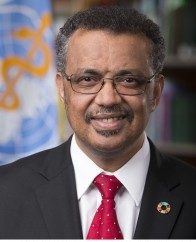

By Dr Tedros Adhanom Ghebreyesus*
Yes, I am from Tigray, and this crisis affects me
Geneva: Although Ukraine is the focus of the world’s attention, it is far from the only crisis to which World Health Organization (WHO) is responding.
In Yemen, roughly two-thirds of the population, more than twenty million people, are estimated to be in need of health assistance. In Afghanistan, more than half the population is in need, with widespread malnutrition and a surge in measles, among many other challenges.
And in Ethiopia, 6 million people in Tigray have been under blockade by Ethiopian and Eritrean forces for almost 500 days, sealed off from the outside world. There is almost no fuel, no cash, and no communications. No food aid has been delivered since the middle of December. 83% of the population is food insecure. Our partners are running out of what little food they have, and the fuel to transport it. About three-quarters of health facilities assessed by WHO have been damaged or destroyed.
In February, WHO airlifted more than 33 metric tonnes of medicines and other supplies to Tigray – enough for 300 thousand people – the first time we have been able to deliver supplies since July last year. In the past two weeks, WHO and our partners have distributed supplies to 65 health facilities in Tigray, but much more is needed, and we are now preparing to send an additional 95 metric tonnes of supplies, but no permission has been given yet.
We estimate that 2,200 metric tons of emergency health supplies are needed to respond to urgent health needs in Tigray. Only 117 metric tons have been delivered – less than 1% of what is needed. But with no fuel, even if we can get supplies in, getting them to where they need to go is very difficult, or impossible.
The humanitarian situation in the neighbouring Afar region also continues to deteriorate, with tens of thousands of people displaced and in need of food, shelter and health services. But while the neighbouring regions of Afar and Amhara are also affected, we have had far better access to those two regions than we have in Tigray.
What’s the impact of all this? People are dying.
There is no treatment for forty-six thousand people who need treatment for HIV, and the programme has been abandoned. People with tuberculosis, hypertension, diabetes and cancer are also not being treated and may have died. As a result of the lack of fuel, some of our partners are having to scale back their operations.
The situation is catastrophic. The blockade on communications, including on journalists being able to report from Tigray, means it remains a forgotten crisis – out of sight, and out of mind.
Yes, I am from Tigray, and this crisis affects me, my family and my friends very personally. But as the Director-General of WHO, I have a duty to protect and promote health wherever it is under threat, and there is nowhere on earth where the health of millions of people is more under threat than in Tigray.
Just as we continue to call on Russia to make peace in Ukraine, so we continue to call on Ethiopia and Eritrea to end the blockade – the siege – and allow safe access for humanitarian supplies and workers to save lives.
Peace is the only solution – in Ukraine, Yemen, Afghanistan, and Ethiopia.
*Dr Tedros Adhanom Ghebreyesus is the Director-General of WHO. Excerpts from his speech during a press conference in Geneva today





